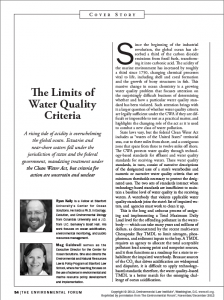“The Limits of Water Quality Criteria” by Meg Caldwell and Ryan Kelly
The November-December 2012 issue of the Environmental Law Institute’s policy journal The Environmental Forum features The Limits of Water Quality Criteria by Meg Caldwell and Ryan Kelly. Meg Caldwell is the Executive Director for the Center for Ocean Solutions. She also directs the Environmental and Natural Resources Law & Policy Program at Stanford Law School, where her teaching focuses on the use of science in environmental and marine resource policy development and implementation.
Ryan Kelly is an Analyst for Science, Law, and Policy with Stanford University’s Center for Ocean Solutions.
Published in The Environmental Forum, Volume 29, No. 6:
A rising tide of acidity is overwhelming the global ocean. Estuaries and near-shore waters fall under the jurisdiction of states and the federal government, mandating treatment under the Clean Water Act, but criteria for action are uncertain and unclear.

Since the beginning of the industrial revolution, the global ocean has absorbed a third of the carbon dioxide emissions from fossil fuels, transforming it into carbonic acid. The acidity of the marine environment has increased by roughly a third since 1750, changing chemical processes vital to life, including shell and coral formation and the growth of bony structures in fish. This massive change in ocean chemistry is a growing water quality problem that focuses attention on the surprisingly difficult business of determining whether and how a particular water quality standard has been violated. Such attention brings with it a larger question of whether water quality criteria are legally sufficient under the CWA if they are difficult or impossible to test as a practical matter, and highlights the changing role of the act as it is used to combat a new class of water pollution.
State laws vary, but the federal Clean Water Act includes as “waters of the United States” territorial seas, out to three miles from shore, and a contiguous zone that spans from three to twelve miles off shore. The CWA protects water quality through technology-based standards for effluent and water quality standards for receiving waters. These water quality standards, in turn, consist of narrative descriptions of the designated uses of a state’s waterbodies and numeric or narrative water quality criteria that set minimum thresholds necessary to protect the designated uses. The two sets of standards interact when technology-based standards are insufficient to maintain a baseline level of water quality in the receiving waters. A waterbody that violates applicable water quality standards joins the state’s list of impaired waters, and agencies must work to clean it up.
